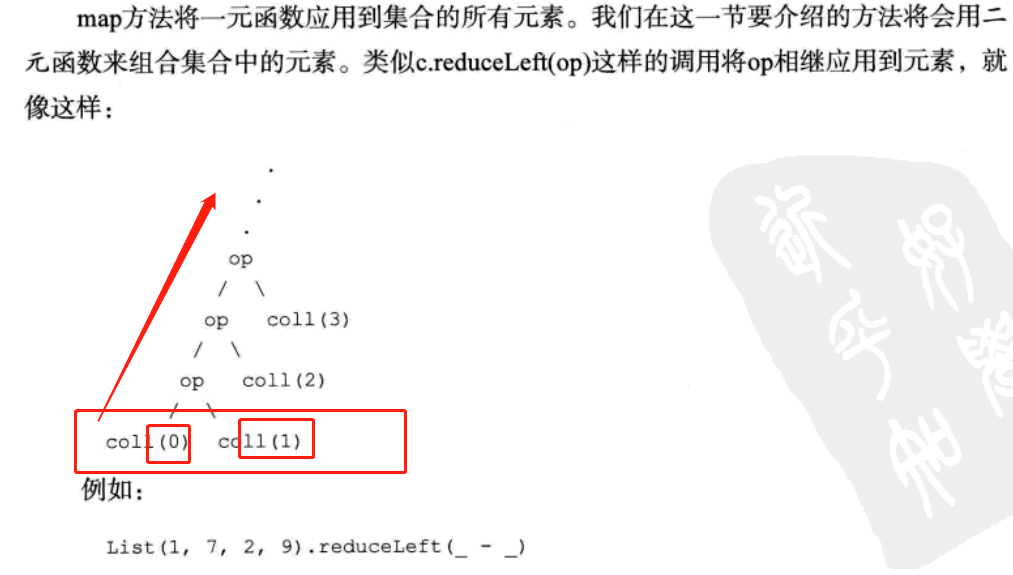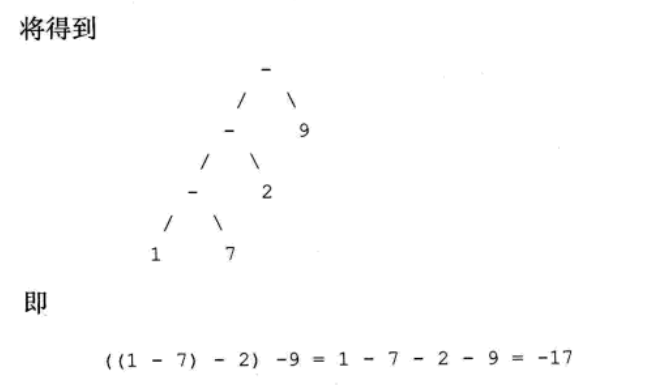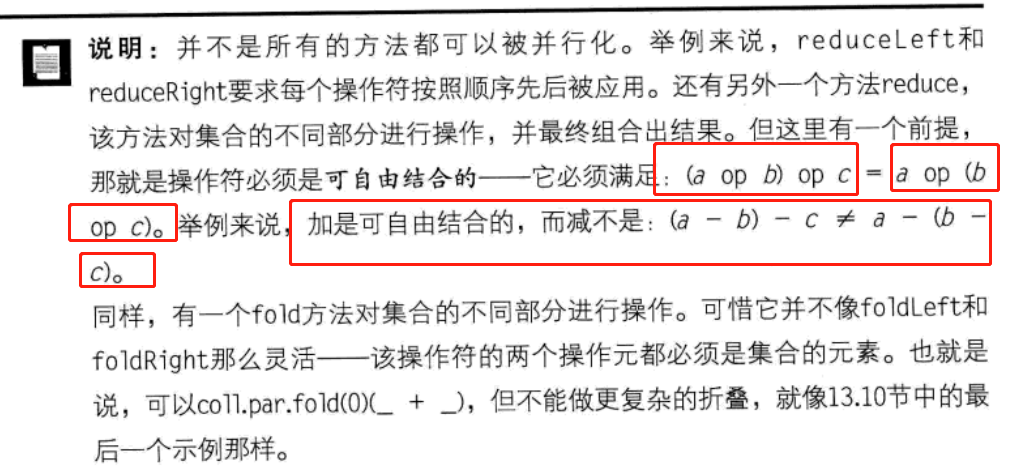在Scala中,我们可以使用reduce这种二元操作对集合中的元素进行归约。
reduce包含reduceLeft和reduceRight两种操作,前者从集合的头部开始操作,后者从集合的尾部开始操作。


下面我们在Scala解释器中运行代码。
- scala> val list = List(1,2,3,4,5)
- list: List[Int] = List(1, 2, 3, 4, 5)
- scala> list.reduceLeft(_ + _)
- res21: Int = 15
- scala> list.reduceRight(_ + _)
- res22: Int = 15
可以看出,reduceLeft和reduceRight都是针对两两元素进行操作,在上面代码中,reduceLeft(_ + _)表示从列表头部开始,对两两元素进行求和操作,下划线是占位符,用来表示当前获取的两个元素,两个下划线之间的是操作符,表示对两个元素进行的操作,这里是加法操作(你也可以使用乘法*或者减法-等其他操作)。整个加法操作的执行顺序如下:
1+2 = 3
3+3 = 6
6+4 = 10
10+5 = 15
reduceRight(_ + _)表示从列表尾部开始,对两两元素进行求和操作,顺序如下:
4+5 = 9
3+9 = 12
2+12 = 14
1+14 = 15

上面是加法操作,看不出结果的区别,下面可以用减法操作,reduceLeft和reduceRight就会得到不同的结果:
scala> val list = List(1,2,3,4,5)
list: List[Int] = List(1, 2, 3, 4, 5)
scala> list.reduceLeft(_ - _)
res25: Int = -13
scala> list.reduceRight(_ - _)
res26: Int = 3
实际上,我们可以直接使用reduce,而不用reduceLeft和reduceRight,这时,默认采用的是reduceLeft,如下:
scala> val list = List(1,2,3,4,5)
list: List[Int] = List(1, 2, 3, 4, 5)
scala> list.reduce(_ - _)
res29: Int = -13 //可以看出,得到的结果和reduceLeft的结果是一样的
 ----------
----------
Problem
你想要遍历有序集合的所有元素,并且随着你对集合元素的遍历,对比两个相邻的元素
Solution
使用reduceLeft, foldLeft, reduceRight, foldRight来遍历集合的元素,你的方法作用在相邻的两个元素上,从第一次要遍历的两个相邻元素开始,把你的方法作用在这两个元素上得到返回值,然后把你的方法继续作用在返回值和集合中第三要遍历的元素得到的返回值,再继续和第四个要遍历的元素作用。。。直到遍历完最后一个元素为止:
scala> val a = Array(12, 6, 15, 2, 20, 9)
a: Array[Int] = Array(12, 6, 15, 2, 20, 9)
scala> a.reduceLeft(_ + _)
res32: Int = 64这个例子是这样的:12+6=18, 18+15=33, 33+2=35, 35+20=55, 55+9=64,就是对集合的所有元素求和
接下来你会看到如何使用reduceLeft来计算集合元素的乘积和求最大最小值:
scala> a.reduceLeft(_ * _)
res33: Int = 388800
scala> a.reduceLeft(_ min _)
res34: Int = 2
scala> a.reduceLeft(_ max _)
res35: Int = 20Show each step in the process
我们来看看reduceLeft的执行细节:
val findMax = (x: Int, y: Int) => {
val winner = x max y
println(s"compared $x to $y, $winner was larger")
winner
}scala> a.reduceLeft((x,y) => findMax(x,y))
compared 12 to 6, 12 was larger
compared 12 to 15, 15 was larger
compared 15 to 2, 15 was larger
compared 15 to 20, 20 was larger
compared 20 to 9, 20 was larger
res38: Int = 20上面的输出信息展示了reduceLeft是如何遍历集合中的每一个元素,并在每一步时是如何调用传入的函数操作集合元素的。我们来总结一下reduceLeft的操作步骤:
- reduceLeft开始调用findMax方来来比较集合的前两个元素,12和6,findMax方法返回12,因为12>6
- reduceLeft接下来使用第一次调用findMax的返回值12和集合的第三个元素15,调用findMax(12, 15),因为15>12所以findMax返回15
- reduceLeft接下来用每一步执行的返回值和集合的下一个元素传入findMax方法,返回较大的值,直到遍历完集合的最后一个元素,返回最大值20
我们来换种方法来模拟reduceLeft的功能:
// you provide the sequence 'seq' and the function 'f'
var result = seq(0)
for (i <- 1 until seq.length) {
val next = seq(i)
result = f(result, next)
}一个关于reduceLeft方法非常微妙并且重要的事项:传入的方法的返回值类型必须是要和集合中存储的数据类型相同的。这是非常必要的,因为reduceLeft会对比方法的返回值和集合中的下一个元素。
Working with other sequences and types
正如你想象的,集合包涵的数据类型可以是任何你想要的。举个例子,遍历一个字符串序列通过一个方法来确定最长的活着最短的字符串:
scala> val peeps = Vector("al", "hannah", "emily", "christina", "aleka")
peeps: scala.collection.immutable.Vector[String] = Vector(al, hannah, emily, christina, aleka)
scala> peeps.reduceLeft((x,y) => if(x.length >= y.length) x else y)
res5: String = christinafoldLeft, reduceRight, and foldRight
方法foldLeft与reduceLeft工作方法很想,但是它让你指定一个值作为第一个元素。下面这个例子真是了求和算法,第一个是reduceLeft方法,后面是foldLeft方法,我们来看看它们的区别:
scala> val a = Array(1, 2, 3)
a: Array[Int] = Array(1, 2, 3)
scala> a.reduceLeft(_+_)
res6: Int = 6
scala> a.foldLeft(100)(_+_)
res7: Int = 106
scala> a.foldLeft(200)(_+_)
res8: Int = 206上面最后两个例子中foldLeft分别使用了100,200作为首元素,这个值直接影响到了最终求和的结果。如果你还从没有见过这样的语法,就拿foldLeft接受两个参数列表来解释一下把。第一个参数表接受一个字段,种子值。第二个参数表是一个你想要运行的代码块。方法reduceRight和foldRight执行方式和reduceLeft和foldLeft一样,但是它们是从集合的最后一个元素开始遍历,然后从右到左,直到遍历到集合的开始位置。
The difference between reduceLeft and reduceRight
在许多算法中,你可能并不在意使用reduceLeft还是reduceRight。在这种情况下,你可以使用reduce方法代替。Scala文档中对reduce的说明:“对元素的操作顺序是不明的或者不确定的”。
但是还有许多算法会对两种方法返回不同的结果。举个例子,divide函数:
val divide = (x: Double, y: Double) => {
val result = x / y
println(s"divided $x by $y to yield $result")
result
}
scala> def divide(x:Double, y:Double):Double = {
| val result = x / y
| println(s"divided $x by $y to yield $result")
| result
| }
divide: (x: Double, y: Double)Double定义一个集合,分别查看调用reduceLeft和reduceRight的结果:
scala> val a = Array(1.0, 2.0, 3.0)
scala> a.reduceLeft((x,y) => divide(x,y))
divided 1.0 by 2.0 to yield 0.5
divided 0.5 by 3.0 to yield 0.16666666666666666
res10: Double = 0.16666666666666666
scala> a.reduceRight((x,y) => divide(x,y))
divided 2.0 by 3.0 to yield 0.6666666666666666
divided 1.0 by 0.6666666666666666 to yield 1.5
res11: Double = 1.5scanLeft and scanRight
方法scanLeft和scanRight也会变了整个集合,类似于reduceLeft和reduceRight,但是它们返回一个集合而不是一个值。
举个例子,scanLeft产生一个集合,集合元素为从左到右遍历遍历集合并对集合元素调用操作函数产生返回值。为了理解这事如何工作的,我们新建一个带有debug的方法:
scala> def product(x:Int, y:Int):Int = {
| val result = x * y
| println(s"multiplied $x by $y to yield $result")
| result
| }
product: (x: Int, y: Int)Int
scala> val a = Array(1,2,3)
a: Array[Int] = Array(1, 2, 3)
scala> a.scanLeft(10)(product)
multiplied 10 by 1 to yield 10
multiplied 10 by 2 to yield 20
multiplied 20 by 3 to yield 60
res12: Array[Int] = Array(10, 10, 20, 60)正如你看到的,scanLeft返回了一个新的集合,而不是一个值。方法scanRight以同样的方式工作,不过是从右到左遍历集合。
那还有一些相关的方法,包含reduce,reduceLeftOption,reduceRightOption。
如果你关心reduce方法的情况,那么运行这段代码来看看吧:
scala> def findMax(x:Int, y:Int):Int = {
| Thread.sleep(10)
| val winner = x max y
| println(s"compared $x and $y, the winner is $winner")
| winner
| }
findMax: (x: Int, y: Int)Int
scala> val a = Array.range(0,50)
a: Array[Int] = Array(0, 1, 2, 3, 4, 5, 6, 7, 8, 9, 10, 11, 12, 13, 14, 15, 16, 17, 18, 19, 20, 21, 22, 23, 24, 25, 26, 27, 28, 29, 30, 31, 32, 33, 34, 35, 36, 37, 38, 39, 40, 41, 42, 43, 44, 45, 46, 47, 48, 49)
scala> a.reduce(findMax)
compared 0 and 1, the winner is 1
compared 1 and 2, the winner is 2
compared 2 and 3, the winner is 3
compared 3 and 4, the winner is 4
compared 4 and 5, the winner is 5
compared 5 and 6, the winner is 6
compared 6 and 7, the winner is 7
compared 7 and 8, the winner is 8
compared 8 and 9, the winner is 9
compared 9 and 10, the winner is 10
compared 10 and 11, the winner is 11
compared 11 and 12, the winner is 12
compared 12 and 13, the winner is 13
compared 13 and 14, the winner is 14
compared 14 and 15, the winner is 15
compared 15 and 16, the winner is 16
compared 16 and 17, the winner is 17
compared 17 and 18, the winner is 18
compared 18 and 19, the winner is 19
compared 19 and 20, the winner is 20
compared 20 and 21, the winner is 21
compared 21 and 22, the winner is 22
compared 22 and 23, the winner is 23
compared 23 and 24, the winner is 24
compared 24 and 25, the winner is 25
compared 25 and 26, the winner is 26
compared 26 and 27, the winner is 27
compared 27 and 28, the winner is 28
compared 28 and 29, the winner is 29
compared 29 and 30, the winner is 30
compared 30 and 31, the winner is 31
compared 31 and 32, the winner is 32
compared 32 and 33, the winner is 33
compared 33 and 34, the winner is 34
compared 34 and 35, the winner is 35
compared 35 and 36, the winner is 36
compared 36 and 37, the winner is 37
compared 37 and 38, the winner is 38
compared 38 and 39, the winner is 39
compared 39 and 40, the winner is 40
compared 40 and 41, the winner is 41
compared 41 and 42, the winner is 42
compared 42 and 43, the winner is 43
compared 43 and 44, the winner is 44
compared 44 and 45, the winner is 45
compared 45 and 46, the winner is 46
compared 46 and 47, the winner is 47
compared 47 and 48, the winner is 48
compared 48 and 49, the winner is 49
res13: Int = 49 